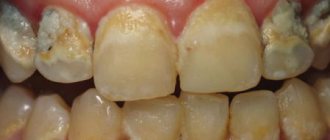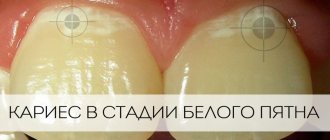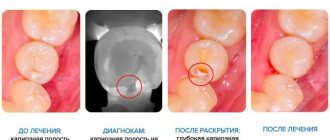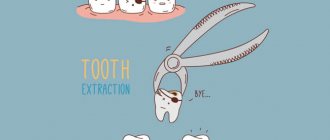The health of a child’s teeth is established during the period of intrauterine development. If the expectant mother consults the dentist on time, observes oral hygiene, diet and other recommendations for pregnant women, then the likelihood of healthy teeth in the future baby is quite high. However, the environmental situation, individual characteristics and heredity lead to the child developing dental diseases. One of the most common is caries, the development of which in the early stages can be stopped by silvering the teeth. This procedure stops the growth and reproduction of microorganisms, the waste products of which destroy teeth, leading to the appearance of carious cavities.
CARIES OF MILK TEETH
Why are some children susceptible to dental caries, while others are not? Factors:
- genetic predisposition;
- poor quality nutrition;
- poor oral hygiene;
- frequent infection;
- Abuse of sweets.
Removing carious teeth is not a solution, since the absence of teeth in the jaw negatively affects the formation of the bite.
The enamel of baby teeth is not saturated with minerals, like that of permanent molars. The passion for sweets has a bad effect on the protective layer, and the tooth is affected by caries. A child’s teeth need constant strengthening and protection.
Therefore, parents should be attentive to the health of their child’s teeth, regularly show him to the dentist and take preventive measures - silvering of teeth.
To silver teeth or not?
Silvering is a painless procedure, but its effect may not only not meet your expectations, but also negatively affect the child’s attitude towards dental treatment.
Firstly, before the procedure, the doctor needs to thoroughly clean the baby’s teeth, and this can frighten him. Secondly, the black color of the enamel will cause psychological discomfort to the baby - he will begin to feel embarrassed about his smile.
In addition, silvering of a tooth with moderate or deep caries can be dangerous. Bacteria remain sealed in the dentinal tubules and actively multiply there, while the enamel darkened due to silver nitrate does not even give parents a chance to notice this process. As a result, caries develops into pulpitis within a few months, and a tooth that could be saved has to be removed.
In addition, during the procedure, the composition may get on the gums. Itching, redness or burns occur in this area, and even an allergic reaction is possible.
Silvering of teeth does not cure, it can only stop the development of caries, but only when it comes to damage to the upper layer of enamel.
SILVERING OF MILK TEETH
Silvering protects baby teeth from the development of caries, and at the very beginning of carious decay. The surface of the molars is coated with a special solution containing silver, which hardens and forms a protective film.
The composition consists of antiseptic materials that destroy decay-causing bacteria. As a result, the teeth remain intact, and the child avoids treatment with a drill.
The child does not see scary dental instruments and does not feel pain - these are the advantages of silvering. If parents take them to the dentist before carious lesions develop, tooth decay can be completely prevented.
Advantages of silver plating:
- stops the development of caries;
- preserves the installed seal;
- protects sensitive teeth from the temperature effects of food;
- accessible to everyone;
- does not cause pain or discomfort.
Silvering is also indicated for those children whose parents are susceptible to severe dental caries. This procedure will save the child from the destruction of baby teeth.
Despite all the advantages, the procedure must be approved by a dentist, because silver plating has contraindications:
- the procedure is not effective when dentin is damaged, because the bacteria have penetrated deep into the tooth;
- does not always help prevent caries on chewing molars due to the complexity of the surface structure;
- requires preliminary cleaning of molars before coating;
- blackening of teeth.
Sometimes professional cleaning of molars before silvering can cause fear in a child. It is necessary to set the baby in a positive mood or somehow distract his attention.
Another significant reason for refusing silver plating is aesthetic inconsistency. After silvering, milk teeth darken and do not look aesthetically pleasing.
Is silvering baby teeth a panacea for caries? Unfortunately no. If the tooth has already undergone carious destruction, silvering can only delay the cleansing of the molar from traces of destruction and the placement of a filling.
The disadvantages include a peculiar aftertaste after covering the molars with a composition containing silver.
Prevention of caries in children
What should be done to protect the dental health of the little ones?
It is necessary to clean the teeth of even the smallest children from the beginning of complementary feeding. At this time, babies’ teeth are quite soft, which means microorganisms can quickly destroy them. With the help of soft silicone brushes that fit on the finger, the mother can clean the child’s teeth from plaque and food debris.
Over time, you can switch to soft baby brushes. Fortunately, you can find hundreds of types of toothbrushes and special toothpastes on sale. Everyone will be able to choose the appropriate option for themselves.
But even careful dental care for children does not exclude the possibility of developing caries. It is necessary to visit the dentist to prevent the development of the disease. Silvering is one of the options for dental treatment.
INDICATIONS
Do all children need the silvering procedure? There are a number of direct indications for the use of silvering:
- living in a region with water without fluoride;
- strengthening the molar after installing a filling;
- prevention of caries development on molars;
- violation of the integrity of the molar - crack, chip;
- a white spot on the crown of a tooth is the beginning of carious development;
- protecting sensitive teeth from food exposure;
- thin layer of enamel.
Why is it carried out?
Caries that occurs in children develops very quickly. As a result of its progression, the child loses his milk teeth. In addition to the pain associated with the formation of the disease, children will face orthodontic problems in the future.
Many parents do not understand the consequences of early loss of baby teeth. In fact, their absence leads to the formation of a malocclusion. Permanent teeth grow out deformed. The absence of baby teeth also affects the baby's speech. He may pronounce individual sounds or entire words incorrectly.
Due to the reasons described, it is important to prevent premature loss of baby teeth. Since it is difficult to persuade a small child to sit under a drill and not move, it is customary to resort to the silvering procedure. It allows you to slow down the rate of caries development for some time , and therefore maintain the correct bite.
CONTRAINDICATIONS
Firstly, the procedure is not performed if there is deep damage to the dental tissue. The composition of the drug is not intended to affect the internal tissues of the molar and may cause harm instead of benefit.
Secondly, the procedure is not carried out if there are existing pathologies of dental tissue or allergies to medicinal substances included in the solution.
Thirdly, coverage is not possible for existing somatic pathologies.
Fourthly, age from three years. Older patients undergo different treatment, for example, using a drill and placing a filling.
CARRYING OUT THE PROCEDURE
First, the dentist cleans the surface of the tooth so that no foreign particles from food remain on it. Then apply the mixture with a cotton swab and leave until hardened. They don't do anything else.
What is the coating solution made of? It contains silver nitrate - 30%. In dental practice, fluoride compounds can be added to silver nitrate, which have a strengthening effect on the enamel.
Note! The method of silvering baby teeth will need to be repeated several times. The dentist will notify you about this.
How many times does silvering need to be done? Sometimes this is done every three months, sometimes the baby needs to repeat the procedure every six months. What determines the frequency of the procedure? This is due to the type of feeding (breastfeeding or formula feeding) and the structure of the enamel of the molars. Thin enamel requires more careful care than durable enamel.
When is re-silvering required? The film wears off over time due to chewing of food. The silver film reacts to acids from food, so the child must be shown to the dentist regularly.
ARGENATE AND SAPHORITE
Modern dentistry suggests using drugs such as Argenate and Saforite containing silver fluoride diamine.
Argenate can be one-component or two-component. One-component is used to strengthen enamel and clog dentin tubules. The two-component drug has a similar effect for a longer period. It is used in the treatment of cervical caries, since the petroleum jelly contained in the composition protects the mucous membrane from burns by silver ions. After using Argenate, a dark film forms on the teeth, just like after silvering.
The drug Saforide is an analogue of Argenate of Japanese origin, therefore it costs many times more. In terms of the quality of the effect, it does not differ from Argenate. After imported drugs, teeth darken in the same way and are not cleaned with toothpastes.
Write a comment
Olga
January 5, 2015 at 15:00
Indeed, with the appearance of the first tooth, we need to start thinking about protection. Having seen how a child we know at the age of four has already had several baby teeth pulled out, and the rest have caries, we have been taking our son to the pediatric dentist since he was a year old. And when at the age of three he we began to see minor signs of caries; without thinking about the price, we did fluoridation, since I consider it more effective than silvering. The development of caries has really stopped, but of course there must also be adequate hygiene and a good electric toothbrush. You can’t save on our children’s teeth .
Lelya.
February 4, 2015 at 11:58 am
Hello! We are also faced with the problem of baby teeth. My daughter is 6 years old and lately she has been complaining about pain in her teeth. I somehow didn’t pay attention to this, because she is a very good dreamer and I told her that she needed to take care of her teeth and eat less sweets. And then I actually discovered black spots on her back teeth and realized that a pediatric dentist was inevitable. So he advised us to silver plate. Of course, it’s a little expensive, but we didn’t refuse, although in our case it was already a little too old. This is real protection for children's teeth. Silvering not only slows down the loss of baby teeth, but also protects them from caries, and therefore from painful sensations for the baby. Our son is still growing, he is 8 months old and has no teeth, as soon as we appear for silver!!! What we recommend to everyone!
Julia
April 13, 2021 at 11:13 pm
My child is 3.5 years old. Black spots appeared on the front teeth. We went to the children's clinic and they said it was caries. They also reported that they do not treat caries on the front teeth, nor do they do silver plating. They suggested going to a paid clinic. There they also refused us, they said we don’t need to silver it, let it stay that way, if it bothers us, we’ll remove it. Fluoridation is not done. They advised, however, to use Rox gel to remineralize teeth.
Valya
October 20, 2021 at 11:22 am
I don’t know for what reason they refused to silver your child’s teeth, but my front teeth were silvered at the age of 1.5 years and they told me to carry out this procedure every 6 months. Absolutely free. To be honest, we were not offered any paid alternatives. Yes, my daughter walks around with black teeth, but I think the most important thing is that she has them. Soon we will be 3 years old, other manipulations with her teeth may be available
Karina
October 10, 2021 at 01:02 pm
At the age of 4, my son’s front teeth began to decay from hard tap water. The pediatric dentist recommended silver plating. So we kept going and silvering until his milkweeds began to fall out. The procedure in pediatric dentistry was carried out free of charge. The condition of the remaining teeth was normal. The son walked around and scared everyone with his black teeth.










